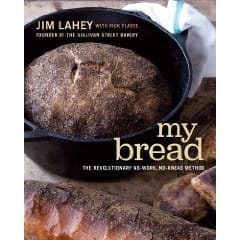Courtesy of SteamyKitchen. This is the same guy from whom Mark Bittman cribbed his no knead bread recipe.
No Knead Baguette (Stecca) Recipe
Recipe from My Bread: The Revolutionary No-Work, No-Knead Method by Jim Lahey. If you want to keep the baguettes plain, just skip the step of embedding the garlic, olives and cherry tomatoes.
My Bread: The Revolutionary No-Work, No-Knead Method by Jim Lahey. If you want to keep the baguettes plain, just skip the step of embedding the garlic, olives and cherry tomatoes.3 cups (400 grams) bread flour
1/2 teaspoon table salt
3/4 teaspoon sugar
1/4 teaspoon instant or other active dry yeast
1 1/2 cups (350 grams) cool 55-65F water
additional flour for dusting
20 pieces of the any combination of following: whole garlic cloves, whole olives, halved cherry tomatoes
1/4 cup extra virgin olive oil
3/4 teaspoon coarse sea salt or kosher salt
1. In a medium bowl, stir together the flour, table salt, sugar and yeast. Add the water and, using a wooden spoon, mix until you have a wet, sticky dough, about 30 seconds. Cover the bowl and let sit at room temperature until the surface is dotted with bubbles and the dough is more than doubled in size, 10 to 18 hours (24 hours if you have a cold cold home.)
2. When the first rise is complete, generously dust a work surface with flour. Use a bowl scraper or rubber spatula to scrape the dough out of the bowl in one piece. Fold the dough over itself to her three times and gently shape it into a somewhat flattened ball. Brush the surface of the dough with some of the olive oil and sprinkle with 1/4 teaspoon of the coarse salt (which will gradually dissolve on the surface).
3. Grab a large bowl (large enough to hold the dough when it doubles in size. you could also use a large pot) and brush the insides of the bowl with olive oil. Gently place the dough, seam side down into the bowl. Cover bowl with a towel. Place in a warm draft free spot to rise for 1 to 2 hours. The dough is ready when it is almost doubled. If you gently poke it with your finger, it should hold the impression. If it springs back, let it rise for another 15 minutes.
4. Half an hour before the end of the second rise, pre-heat the oven to 500F, with a rack in the center. Oil a 13″ x 18″ x 1″ baking sheet.
5. Cut the dough into quarters. Gently stretch each piece evenly into a long, thin, baguette shape approximately the length of the pan. Place on the pan, leaving about 1 inch between the loaves. Embed the garlic cloves, olives or cherry tomatoes into the loaves, about five pieces per loaf. Drizzle, tab or brush olive oil on each loaf. Sprinkle sea salt or kosher salt over each loaf, remember to go light on the olive loaf since the olives are salty.
6. Bake For 15 to 25 minutes, until the crust is golden brown. Cool on a pan for five minutes, then use a spatula to transfer the baguette to a rack to cool thoroughly.
Note: The baguette may become a bit soggy in just a few hours because of the salt on the surface. If that happens, reheat the loaves in a hot oven until crisp.
